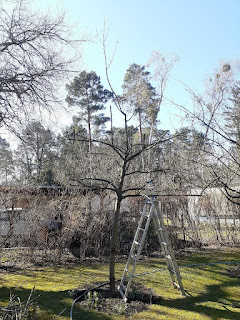 |
| How's the serenity? |
For some it's a drink in hand lying on their favourite deck chair, for others its feeling the sand between their toes and listening to the waves come to shore. These are things that help us relax, unwind and de-stress. In an ever changing world that demands more of us each day it is important for us to find these things that help balance our state of mind.
For me, a combination of the examples above is always a lovely way to chill out. Though there is always one sure fire way for me to feel free - that is to be surrounded by nature, specifically plants and trees. To me, the rustling of tree leaves in the wind is equal to or better than hearing the waves at the beach. Smelling the unique scents that flowers and leaves give off is as exciting as the smell of salt water air at the sea.
Did you know? In Japan today you could visit your doctor and get a prescription to take a walk in the woods if you are feeling stressed, sounds like a pretty sweet deal right? Mental health treatments like this Japanese example are part of a global trend that acknowledges that connecting with nature is a primal experience and a vital tool in humans disconnecting from the world and re-setting our programs.
 |
| Trees are amazing in more ways the obvious beauty they display. |
Know locally in Japan as Shinrin-yoku, at first it sounds like some ancient form of wisdom and although it's roots began in Ancient Persian, this term was only coined only 30 years ago by the Japanese Ministry of Agriculture, Forest and Fisheries to encourage more people to visit forests and make them aware of the very real health benefits from being immersed in nature. Today, around the world, the practice of Forest Bathing is gaining momentum as a very real way to help people from many walks of life better themselves mentally and physically.
In 2018 Doctor Qing Li, Chairman of the Japanese Society of Forest Medicine literally wrote the book on the subject, his 300 odd page "manual" Forest Bathing not only describes the research undertaken regards the theory but also methods of how to put it into practice. For those that don't have a hole heap of time (all of us right?) here is a summary below for what Forest Bathing is all about.
"Forest bathing is like a bridge, by opening our senses, it bridges the gap between us and the natural world."
Firstly you will need to set aside adequate time, a few minutes isn't going to cut it, but whatever you can spare is a start. A 2019 Scientific report recommended 120 minutes a week in nature is associated with measurable health benefits. In Norway it is recommended 5 hours per month to reduce depression, addiction and suicide.
Once you have the time, you'll need the place. The nature you decide to visit doesn't need to be the Amazon Rainforest, let's start with a local park, somewhere close to home or work that is easily accessible, but most importantly somewhere you can feel relaxed. It's important that the park has natural elements such as trees and plants. Make sure you leave you distractions behind as the idea is to engage the senses and not worry about that work email.
"The key to unlocking the power of the forest is in the five sense. Let nature enter through your ears, eyes, nose, mouth, hands and feet."
Now you are in your relaxing setting what can you see? Is there are dense cover of vegetation, how well let/dark is it? What can you hear? Do the songs of birds drown out the noise of cars? It's important to take stock of your surroundings and how it makes you feel - can you notice a difference in temperature? Is there a specific tree or plant that has grabbed your attention? It is important to slow down and be present in the moment.
Each subsequent visit you should challenge yourself to notice something different - a new plant, bird or fungi while you explore. Remember to take your time, it's not a race, stop every once in a while to notice the patterns on leaves or the smell of a crushed leaf. Taking your time will help engage your senses.
 |
| Serenity can come to us in various ways. Bodies of water can increase the calming affect on humans. |
While there is a touchy/feely element to all this, there are also very real and measurable positive affects that have been studied and published. For centuries both philosophers and poets have written about how nature can heal. Nature can inspire both art and literature with the feelings they evoke. Feelings are hard to quantify of course, differing from person to person, but surely the many positive feelings we gain from time in nature must be measurable right?
In his most famous paper American Professor of Healthcare Design Richard Ulrich wrote of the recovery time benefits of hospital rooms with views of trees outside. It was found that those patients who could see trees from their room recovered much quicker from abdominal surgery. Those who had no view of trees or nature from their beds stayed in hospital longer, requiring more medicine for pain relief and in some cases were more depressed during their recovery.
This is just one study of many focusing on how trees can benefit our health. There have been studies published that also strongly indicate the positive effects trees have on us after spending time in nature such as:
* Lowering Blood Pressure
* Lowering or Stress levels
* Improving Cardiovascular & Metabolic health
* Improving Memory & Concentration
* Lowering Depression
* Improving Pain Thresholds
* Improving Energy levels
* Improving Immune System (including increasing the anti-cancer NK cells)
* Improving Sleep
Pretty amazing right?! And all from nature! But how do plants do all this? You may have a little pine tree air freshener hanging from your rear view mirror (or at least seen/smelt one), it releases a nice but manufactured forest smell in your car. This smell may also remind you of a hospital, where they also use chemicals derived from the toxins that Pine trees or Coniferous release to help protect themselves from attacks via insects, bacteria and fungi.
"When you walk in the forest, you are breathing in its healing power."
Air around forested areas is not only higher in oxygen but has a purifying affect, it certainly something our senses can detect. With each breath taken we are helping purify our bodies and helping ourselves to relax. This purifying system is driven by phytoncides which are natural oils with in a plant that hep defend their health (and help ours), they also help plants communicate with each other. The warmer it is the more of these natural oils will be present in the air. In the end a boosted immune system makes us happier.
By 2050, 75% of the projected 9 billion population will live in cities, this will put immense pressure on the way we live. "Technostress" was a term created in 1984 to describe the impact of unhealthy behaviour around new technology. Almost 40 years on this behaviour has become relentless, attributing to many mental health issues such as depression, anxiety and anger issues. The World Health Organisation has already identified stress as the epidemic of the 21st Century.
By re-engaging with nature we can start to tune out the "noise" of present day society. It will also help us tune in or re-set our senses. Ultimately this re-engagement will help with many of these more "modern" health issues. It is hoped that policy makers, town planners and communities will work towards incorporating many nature based solutions into designing city infrastructure and allowing adequate green space to be retained or created.
I am certain you have felt a change while walking through areas with trees. Even if it's the cooling nature when walking down the street on a warm day. You may have been a walk in a park or forest and noticed how your body has slowed down, your senses tune in to plants or animals without thinking about it. It's these natural elements or bodies crave. Now you know a little a bit about why we feel this change and if you haven't really taken noticed it before, I hope you will look out for the sign's next time you make time for nature.
* All quotes above are taken from the Penguin Life book "into the forest" Dr Qing Li



























